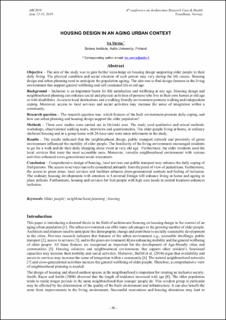| dc.contributor.author | Verma, Ira | |
| dc.date.accessioned | 2021-12-23T13:06:37Z | |
| dc.date.available | 2021-12-23T13:06:37Z | |
| dc.date.issued | 2021 | |
| dc.identifier.isbn | 978-82-536-1718-3 | |
| dc.identifier.issn | 2387-4295 | |
| dc.identifier.uri | https://hdl.handle.net/11250/2835463 | |
| dc.description.abstract | Objective – The aim of the study was to gain further knowledge on housing design supporting older people in their daily living. The physical condition and social situation of each person may vary during the life course. Housing design and urban planning need to anticipate the population ageing. The aim was to find design features in the living environment that support general wellbeing and self-contained life at old age.
Background – Inclusion is an important factor for life satisfaction and wellbeing at any age. Housing design and neighbourhood planning can enhance social and physical activities of persons who live in their own homes at old age or with disabilities. Access to local destinations and a walking friendly environment promote walking and independent coping. Moreover, access to local services and social activities may increase the sense of integration within a community.
Research question – The research question was: which features of the built environment promote daily coping, and how can urban planning and housing design support the older population?
Methods – Three case studies were carried out in Helsinki area. The study used qualitative and mixed methods: workshops, observational walking tours, interviews and questionnaires. The older people living at home, in ordinary sheltered housing and in a group home with 24-hour care were main informants in the study.
Results – The results indicated that the neighbourhood design, public transport network and proximity of green environment influenced the mobility of older people. The familiarity of the living environment encouraged residents to go for a walk and do their daily shopping alone event at very old age. Furthermore, the older residents used the local services that were the most accessible ones. Moreover, versatile neighbourhood environment with various activities enhanced cross-generational social encounters.
Conclusion – Comprehensive design of housing, local services and public transport may enhance the daily coping of frail persons. The access to services has to be considered primarily from the point of view of pedestrians. Furthermore, the access to green areas, local services and facilities enhance cross-generational contacts and feeling of inclusion. The ordinary housing developments with attention to Universal Design will enhance living at home and ageing in place policies. Furthermore, housing and services for frail people with high care needs in central locations enhances inclusion. | |
| dc.language.iso | eng | |
| dc.publisher | SINTEF Academic Press | |
| dc.relation.ispartof | ARCH19 June 12–13, 2019 – Trondheim, Norway. Proceedings from the 4th Conference on Architecture Research Care & Health | |
| dc.relation.ispartofseries | SINTEF Proceedings;8 | |
| dc.rights | CC BY 4.0 | |
| dc.rights.uri | https://creativecommons.org/licenses/by/4.0/ | |
| dc.subject | Older people | |
| dc.subject | Neighbourhood planning | |
| dc.subject | Housing | |
| dc.title | Housing Design in an Aging Urban Context | |
| dc.type | Chapter | |
| dc.type | Peer reviewed | |
| dc.description.version | publishedVersion | |
| dc.rights.holder | © 2021 The Authors. | |
| dc.subject.nsi | VDP::Medisinske Fag: 700::Helsefag: 800 | |

